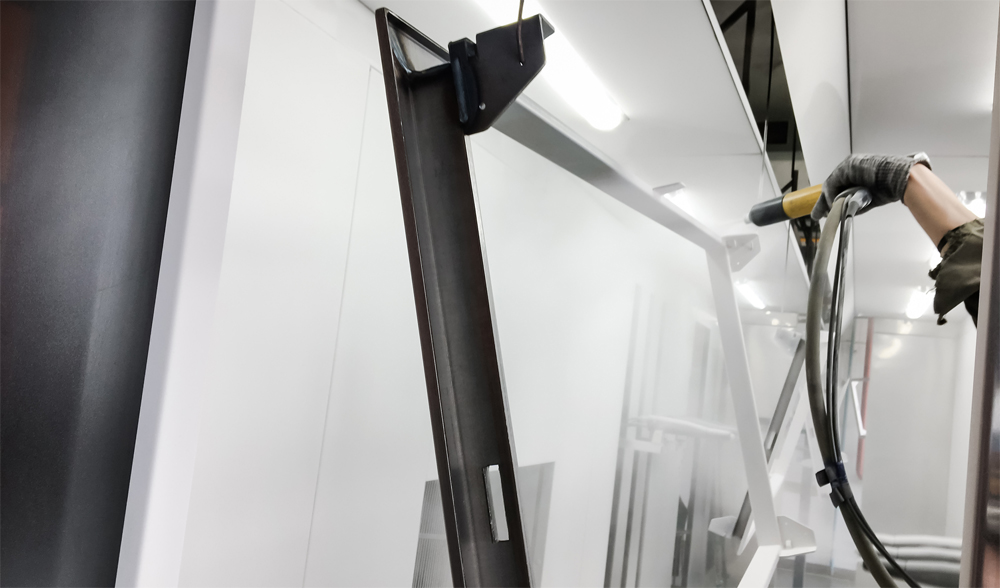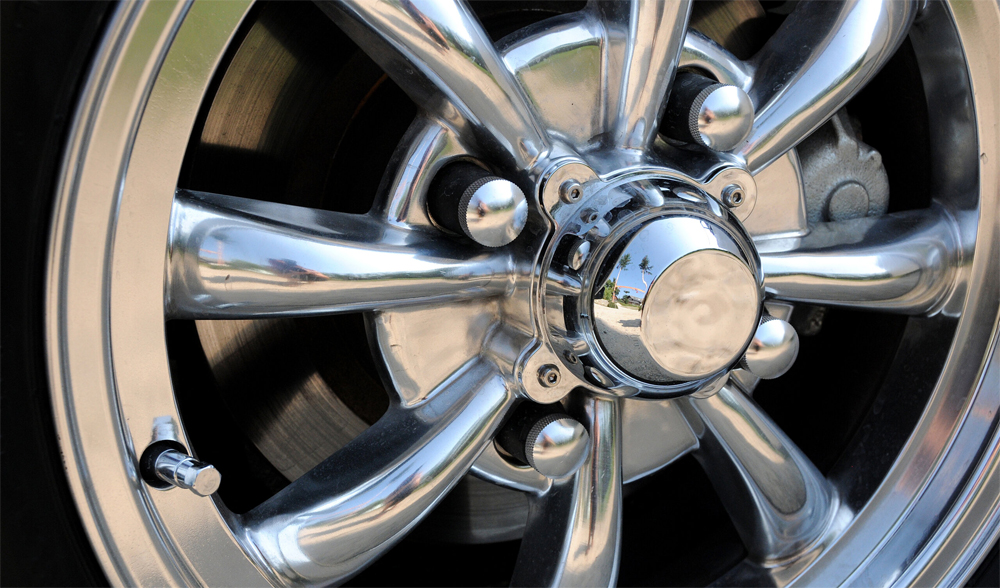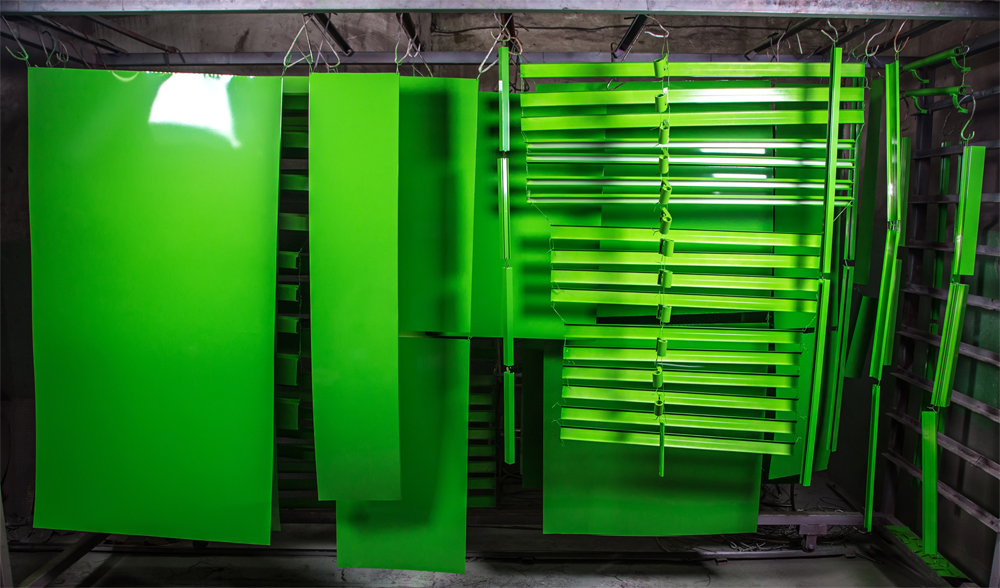Choosing between painting and powder coating for your metal fabrication project can be a daunting task. However, when it comes to durability, environmental impact, and appearance, powder coating is the superior choice over traditional painting finishes.
An Overview of Powder Coating
Powder coating is a dry coating technique that’s widely used to finish metal surfaces, particularly in industrial settings. During the process, a dry powder is electrostatically applied and then heated to cure it. Powder coating is renowned for delivering top-notch finishes that are both functional and visually appealing.
Not only are powder coating finishes durable, but they’re also flexible, making them appropriate for a variety of surfaces, including metal, concrete, steel, and plastic. They’re ideal for both indoor and outdoor applications, and they’re among the most economical finishing alternatives.

Exploring Different Types of Powder Coating
There are two categories of powder coating: thermoset and thermoplastic.
Thermoplastic powder coating finishes become soft and liquid when heated, eliminating chemical bonding. This unique process makes the powder coating reversible and reusable. Additionally, thermoplastic coatings tend to be thicker, making them more durable than thermoset coatings. They can be applied to a variety of surfaces, including metal, auto parts, and refrigerators, making them a versatile option.
In contrast, thermoset powder forms chemical bonds when cured, making it impossible to recycle. It is ideal for use in high-heat areas since the bonds prevent it from melting away. Despite being less expensive than thermoplastic coatings, it is not as durable.
Powder Coating Application
The initial stage of the powder coating process is pre-treatment, which is considered the most crucial step. The effectiveness of the coating’s adhesion to the metal surface is determined by this step, and there are several options for cleaning and prepping the surface. The ideal method involves using a degreaser and/or phosphate rinse, followed by a quick water rinse. Afterward, the powder is sprayed using a spray gun, and curing immediately follows. While there are other techniques available, they are only suitable for specific projects.

The Science Behind Powder Coating Metal
Powder coating is a combination of polymer resin, pigments, curative, flow modifiers, leveling agents, and other additives. These ingredients are melted, mixed, cooled, and ground to form a powder. Preheating ensures a uniform finish, and cooling helps create a hard coating.
Powder coating differs from painting in that it requires an electric charge to work, whereas painting requires an adhesive. The powder is applied using an electrostatic painting sprayer, which imparts a positive electric charge on the powder, accelerating it towards the components. The chemical bonding process strengthens the powder coating, and once cured, the bonds solidify.
Powder coatings have several advantages over traditional painting. For example, they do not produce overspray wastage, and thicker coatings can be added for increased protection and longevity. Additionally, powder coatings are suitable for metal surfaces as they repel corrosive materials like chemicals and water.
Durability of Powder Coating
Without a doubt, this coating is one of the most long-lasting finishes you can apply to many different surfaces, not only metal. The chemical bonds provide an exceptional coating that makes it suitable for industrial equipment as well as everyday items. It withstands harsh weather conditions and physical impact, making it resistant to scratches, abrasions, and chips.
Lifespan of Powder Coating Finishes
The durability of a powder coating finish is influenced by several factors, including the quality of preparation, type of coating used, and the product’s environment. Although powder coatings can last up to 20 years, exposure to UV light and outdoor elements may cause faster breakdown. Coatings with fluoropolymers and urethanes generally have longer lifespans and can withstand extreme conditions, making them ideal for outdoor products. In contrast, epoxy coatings may last longer indoors but are less suitable for outdoor use due to their tendency to break down faster.

Other Benefits of Choosing Powder Coatings
Powder coating offers numerous advantages, making it a highly recommended finish option for metal fabrication. In addition to its exceptional durability, here are some other notable benefits to consider:
Eco-Friendly: Powder coating is an environmentally friendly choice that is both reusable and recyclable. Thermoplastic coatings are particularly easy to reshape, unlike thermosets. Powder coating is also precisely applied with minimal wastage, unlike painting which can result in significant overspray. Typically, the wastage is around 5% or less, and it does not require solvents. Powder coating also does not release volatile organic compounds that could harm the environment. Moreover, it is safer to use and poses less of a health threat than some other finishes, although protective gear is still recommended.
Cost-Effective: Although the initial cost of powder coating may seem high and potentially overwhelming for some, it is much lower in the long run compared to other types of finishes.
Enhanced Appearance: Achieving a polished look when powder coating metal is relatively easy. The fact that powder coating repels chemicals, moisture, and other elements also makes it very easy to clean.
Drawbacks of Powder Coating Finishes
While powder coating offers numerous advantages, it’s important not to overlook its drawbacks. One of these is the difficulty of achieving precise coating control. It may be challenging to achieve the desired thickness and evenness, leading to uneven texture. In cases where the powder coating runs, the entire process may need to be redone.
Another disadvantage is the potential for color inconsistency. Since powder coatings are reusable, there’s a risk of cross-contamination, resulting in colors that don’t match or touch-ups that don’t blend in. This can be prevented by carefully storing powder coatings when not in use to avoid contamination.
Final Thoughts
Powder coating finishes are highly recommended for metal fabrication due to their exceptional qualities. If you have not experienced the benefits of powder coating, you are missing out on a remarkable finish. Feel free to Contact Us to witness the beauty of powder coating on metal.





